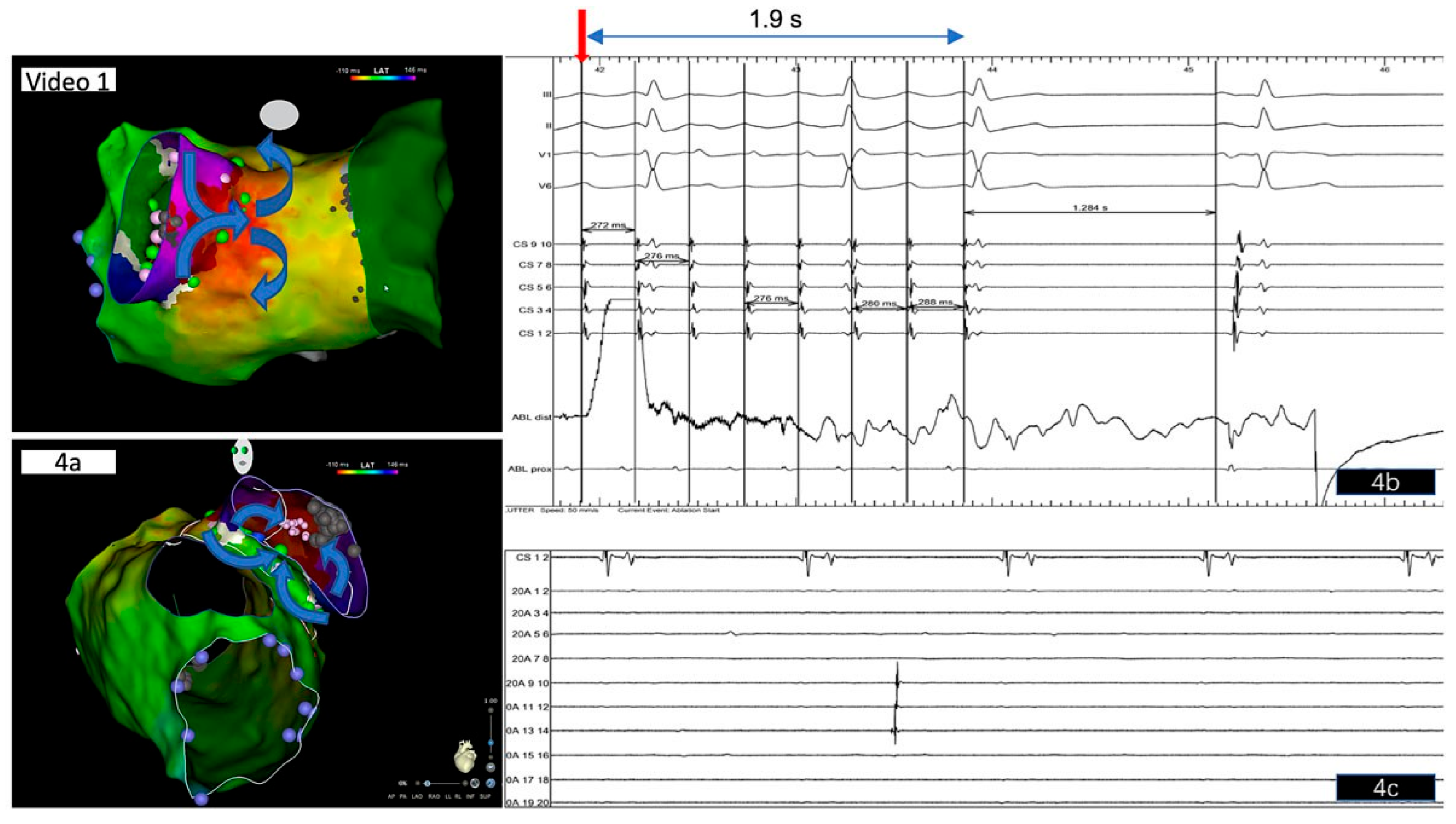Catheter Ablation of Left Atrial Macroreentrant Tachycardia After Bilateral Lung Transplantation
Abstract
Introduction
Case description
Electrophysiological study and ablation
Follow-up
Discussion
Disclosure statement
References
- Waldron, N.H.; Klinger, R.Y.; Hartwig, M.G.; Snyder, L.D.; Daubert, J.P.; Mathew, J.P. Adverse outcomes associated with postoperative atrial arrhythmias after lung transplantation: A meta-analysis and systematic review of the literature. Clin Transplant. 2017, 31. [Google Scholar] [CrossRef]
- Cui, G.; Tung, T.; Kobashigawa, J.; Laks, H.; Sen, L. Increased incidence of atrial flutter associated with the rejection of heart transplantation. Am J Cardiol. 2001, 88, 280–284. [Google Scholar] [CrossRef] [PubMed]
- Baykaner, T.; Cooper, J.M. Atypical flutter following lung transplantation involving recipient-to-donor tissue connections. HeartRhythm Case Rep. 2018, 4, 548–552. [Google Scholar] [CrossRef] [PubMed]
- Itoh, T.; Yamada, T. Left atrial and pulmonary vein flutter associated with double electrical connections after a lung transplantation. Europace. 2017, 19, 855. [Google Scholar] [CrossRef] [PubMed]
- Kim, B.G.; Uhm, J.S.; Yang, P.S.; Yu, H.T.; Kim, T.H.; Joung, B.; et al. Clinical significance of postoperative atrial arrhythmias in patients who underwent lung transplantation. Korean J Intern Med (Korean Assoc Intern Med). 2019. [Google Scholar] [CrossRef]
- Whitbeck, M.G.; Charnigo, R.J.; Khairy, P.; Ziada, K.; Bailey, A.L.; Zegarra, M.M.; et al. Increased mortality among patients taking digoxin—analysis from the AFFIRM study. Eur Heart J. 2013, 34, 1481–1488. [Google Scholar] [CrossRef] [PubMed]
- Nazmul, M.; Munger, T.M.; Powell, B.D. Atrial tachycardia originating from a donor pulmonary vein in a lung transplant recipient. Circulation. 2011, 124, 1288–1289. [Google Scholar] [CrossRef] [PubMed]
- Sacher, F.; Vest, J.; Raymond, J.M.; Stevenson, W.G. Incessant donor-to-recipient atrial tachycardia after bilateral lung transplantation. Heart Rhythm. 2008, 5, 149–151. [Google Scholar] [CrossRef] [PubMed]
- Sanam, K.; Holmes, D.; Shah, D.; Foster, N. Late atrial tachycardia originating from donor pulmonary vein in a double lung transplant recipient. HeartRhythm Case Rep. 2015, 1, 490–493. [Google Scholar] [CrossRef] [PubMed]
- See, V.Y.; Roberts-Thomson, K.C.; Stevenson, W.G.; Camp, P.C.; Koplan, B.A. Atrial arrhythmias after lung transplantation: epidemiology, mechanisms at electrophysiology study, and outcomes. Circ Arrhythm Electrophysiol. 2009, 2, 504–510. [Google Scholar] [CrossRef] [PubMed]
- Uhm, J.S.; Park, M.S.; Joung, B.; Pak, H.N.; Paik, H.C.; Lee, M.H. Intra-atrial reentrant tachycardia originating from the pulmonary vein cuff anastomosis in a lung transplantation patient: Ultra-high-density 3-dimensional mapping. HeartRhythm Case Rep. 2018, 4, 152–154. [Google Scholar] [CrossRef] [PubMed][Green Version]
- Sohns, C.; Saguner, A.M.; Lemes, C.; Santoro, F.; Mathew, S.; Heeger, C.; et al. First clinical experience using a novel high-resolution electroanatomical mapping system for left atrial ablation procedures. Clin Res Cardiol. 2016, 105, 992–1002. [Google Scholar] [CrossRef] [PubMed]
- Santoro, F.; Sohns, C.; Saguner, A.M.; Brunetti, N.D.; Lemes, C.; Mathew, S.; et al. Endocardial voltage mapping of pulmonary veins with an ultra-high-resolution system to evaluate atrial myocardial extensions. Clin Res Cardiol. 2017, 106, 293–299. [Google Scholar] [CrossRef] [PubMed]




© 2020 by the author. Attribution - Non-Commercial - NoDerivatives 4.0.
Share and Cite
Fu, G.; Gonca, S.; Thomas F., M.; Ilhan, I.; Christine A., R.; Ardan M., S. Catheter Ablation of Left Atrial Macroreentrant Tachycardia After Bilateral Lung Transplantation. Cardiovasc. Med. 2020, 23, w02117. https://doi.org/10.4414/cvm.2020.02117
Fu G, Gonca S, Thomas F. M, Ilhan I, Christine A. R, Ardan M. S. Catheter Ablation of Left Atrial Macroreentrant Tachycardia After Bilateral Lung Transplantation. Cardiovascular Medicine. 2020; 23(4):w02117. https://doi.org/10.4414/cvm.2020.02117
Chicago/Turabian StyleFu, Guan, Suna Gonca, Mueller Thomas F., Inci Ilhan, Rüegg Christine A., and Saguner Ardan M. 2020. "Catheter Ablation of Left Atrial Macroreentrant Tachycardia After Bilateral Lung Transplantation" Cardiovascular Medicine 23, no. 4: w02117. https://doi.org/10.4414/cvm.2020.02117
APA StyleFu, G., Gonca, S., Thomas F., M., Ilhan, I., Christine A., R., & Ardan M., S. (2020). Catheter Ablation of Left Atrial Macroreentrant Tachycardia After Bilateral Lung Transplantation. Cardiovascular Medicine, 23(4), w02117. https://doi.org/10.4414/cvm.2020.02117



